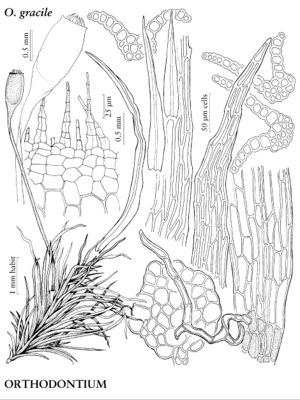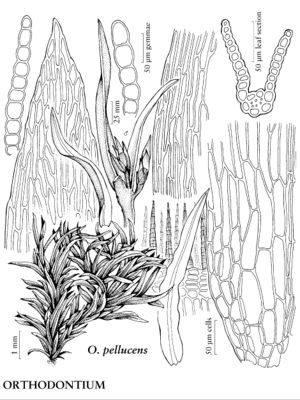Plants small, in loose tufts or scattered individuals, acrocarpous, pseudo-pleurocarpous (reproductive structures on lateral innovations). Stems erect; epidermis not differentiated, central strand present or absent. Leaves linear or setaceous [lanceolate or linear-lanceolate]; base undifferentiated, narrowed to insertion; margins 1-stratose, entire, denticulate in apex; costa 1/3–1/5 leaf width, stereid band present or absent; laminal cells smooth, walls firm. Specialized asexual reproduction frequent, by propagula in leaf axils, reddish brown, filamentous, 1-seriate. Sexual condition autoicous or paroicous; perigonial leaves ovate-lanceolate, to 1/5 stem leaf length, apex acute; perichaetial leaves scarcely differentiated; archegonia scattered distally on stem. Seta elongate, greatly exceeding capsule length. Capsule erect, subcylindric or ovoid-pyriform, irregularly longitudinally wrinkled to somewhat furrowed when dry, tapering to neck; exothecial cells long- to short-rectangular, walls evenly thin; annulus absent or rudimentary, 2- or 3-seriate, adherent to capsule mouth after dehiscence; operculum conic, obliquely rostrate; peristome diplolepidous-alternate; exostome teeth 16, inserted somewhat below mouth, pale yellow-brown, narrowly lanceolate, scarcely trabeculate, smooth or finely papillose, median fissural line present; endostome basal membrane low or absent, segments undivided, hyaline to pale yellow, somewhat reduced, smooth to finely papillose, median line present or absent, cilia absent. Calyptra fugacious, cucullate, smooth, naked. Spores spheric, densely and finely to coarsely papillose.
Distribution
Nearly worldwide, tropical and temperate regions.
Discussion
Genera 4, species ca. 20 (1 genus, 2 species in the flora).
The placement of Orthodontiaceae is currently undergoing rapid revision. B. Goffinet et al. (2008) placed the family in the order Rhizogoniales with Aulacomniaceae and Rhizogoniaceae. This is quite different and distant from the order Bryales, with which Orthodontiaceae has traditionally been associated. W. Frey (2009, part 3) more recently recognized the family in the order Orthodontiales and segregated the other two families to their own orders, Aulacomniales and Rhizogoniales. Orthodontium was elevated to family status by W. R. Buck and Goffinet (2000); however, the genus was retained within Bryaceae by B. H. Allen (2002), who adopted a broader generic view of that large and complex family. Orthodontiaceae is widespread in tropical and temperate regions and primarily epiphytic on coniferous trees, decaying coniferous wood, or in terrestrial habitats.
Selected References
None.

